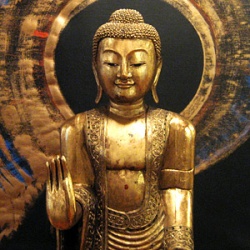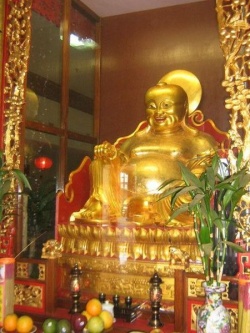Buddharupa
Buddharūpa (बुद्धरूप, literally, "Form of the Awakened One") is the Sanskrit and Pali term used in Buddhism for statues or models of the Buddha.
Commonalities
Despite cultural and regional differences in the interpretations of texts about the life of Gautama Buddha, there are some general guidelines to the attributes of a Buddharupa:
- Fingers and toes are elongated proportionately
- Long, aquiline nose
- Elongated earlobes
- Head protuberance
- Broad shoulders
The elongated earlobes are vestiges of his life as a prince, when he wore extravagant jewellery. The "head protuberance" symbolises the loose connection between the mind and the body of a Buddha or Bodhisattva.
Regional variations
From a gaunt, seated ascetic to a laughing big-bellied wanderer, depictions of the Buddha vary widely across cultures.
Proportions
The Buddharupas of India, Tibet, and the other Buddhist cultures usually depict a well proportioned figure, but sometimes he is shown emaciated, in recollection of the Buddha's years of ascetic practices. Japanese Buddharupas are often very square and stolid, while Indian and Southeast Asian ones often have thinner figures.
Many people may be familiar with the "Happy" or "Laughing" Buddharupa, a different historical figure, who should not be confused with the images of Gautama Buddha. Hotei or Budai, a Chinese Buddhist monk, is depicted as fat and happy, often travelling or bearing wealth.
Postures, gestures and artefacts
Images of Buddha sometimes shown him reclining, recalling the Buddha Shakyamuni's departure into final nirvana.
Other times he is holding various symbolic objects, or making symbolic mudras (gestures).
The clothing also varies; in China and Japan, where it is considered socially improper for monks and nuns to expose the upper arm, the Buddharupa has a tunic and long sleeves, much like the traditional monks and nuns, while in India they are often topless.

